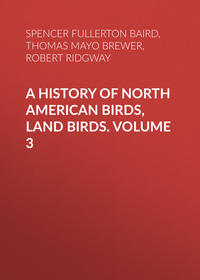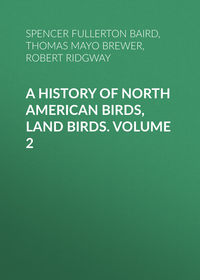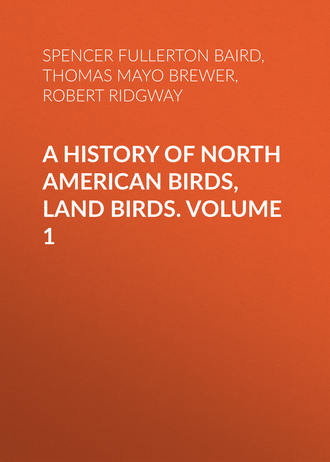 полная версия
полная версияA History of North American Birds, Land Birds. Volume 1
5. V. philadelphicus. Small. Above grayish-green; crown ashy. Beneath light yellow, deepest on the jugulum, whitish on belly. Eyes? Wing, 2.70; tail, 1.95; bill, .27. Hab. Eastern Province of North America; in winter south to Costa Rica.
Series II. (A spurious primary.)C. No dusky line along side of crown. No “mustache.”
6. V. gilva. Eyes hazel (in all?).
a. Crown nearly like the back.
Above olive-gray, rump more virescent; crown more ashy. Beneath dingy whitish, with a strong tinge of dingy buff from bill along sides and across breast. Bill, .14 deep, .30 long; wing, 2.85; tail, 2.05. Hab. Eastern Province of United States … var. gilvus.
Similar, but above more grayish, and beneath with the buff tinge almost absent. Bill, .11 deep, and .22 long; wing, 2.80; tail, 2.15. Hab. Western Province of United States … var. swainsoni.
b. Crown very different from the back (dark brown).
Above olive-brown; rump more virescent; crown dark snuff-brown. Beneath uniform light yellow, throat whitish. Bill, .15 deep, .30 long; wing, 2.60; tail, 2.10. Hab. Middle America, from Ecuador to Honduras … var. josephæ.75
Vireosylvia calidris, var. barbatulus, BairdFLORIDA GREENLETPhyllomanes barbatulus, Cab. Jour. III, 1855, 467 (Cuba).—Gundlach, Cab. Jour. 1861, 324 (Cuba).—Ib. Repertorio, Cuba, 1865. Vireosylvia barbatula, Baird, Rev. Am. B. 1864, 331. Vireo altiloquus, Gambel, Pr. A. N. Sc. 1848, 127 (Florida).—Baird, Birds N. Am. 1858, 354 (Florida). Vireosylvia altiloqua, Cassin, Pr. A. N. Sc. 1851, 152.—Ib. Illust. 1854, 8, and 221, pl. xxxvii (Florida).—Bryant, Pr. Bost. Soc. V, 1859, 113 (Bahamas).—Lawrence, Ann. N. Y. Lyc. 1860 (Cuba).
Sp. Char. (No. 25,958 ♂, Cuba.) Proportion of quills as in var. calidris, 2 = 3, 4, 1, 5, but the tips of the quills closer together, and the first quill about half or a little less than half the distance between fifth and fourth; the quills narrower.
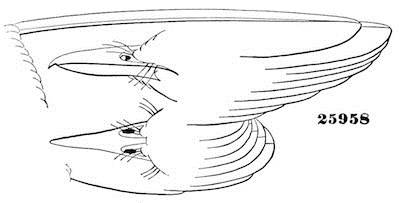
Vireosylvia barbatulus.
25958
Colors similar to those of var. calidris, but of a purer and paler olive above; the back tinged with ash; the cap purer ash, and better defined, without olivaceous wash, its dusky edge more distinct. The superciliary stripe whitish or grayish, with the cheeks paler, and both, as well as the chin, without the buff tinge. Under parts nearly pure white, very faintly tinged across the breast with ashy; the sides olivaceous; the crissum and axillars pale sulphur-yellow. Total length, 5.50; wing, 3.15; tail, 2.50; difference of first and second quills, .18; of fifth and second, .22; length of bill from forehead, .82, from nostril, .46, along gape, .89; tarsus, .72; middle toe and claw, .60; claw alone, .21; hind toe and claw, .50; claw alone, .23.
Hab. Cuba; the Bahamas; and Charlotte Harbor, Florida. (Western Coast.)
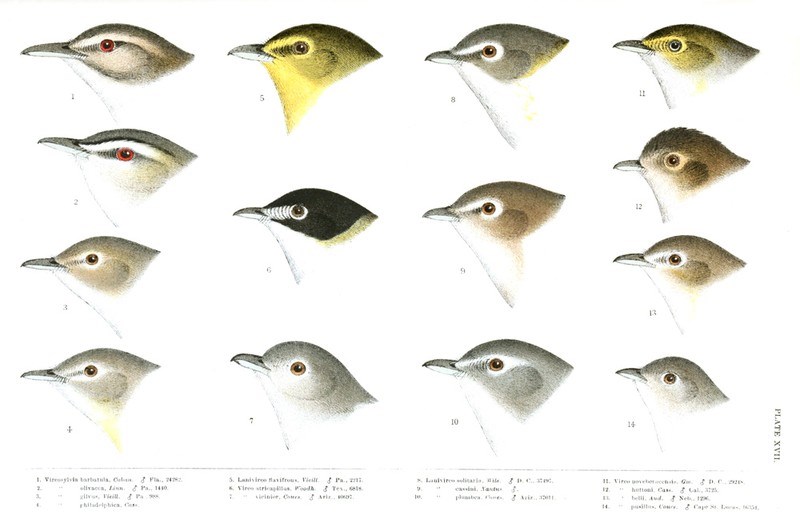
PLATE XVII.
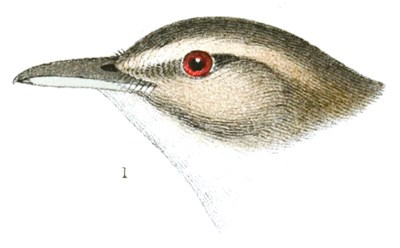
1. Vireosylvia barbatula, Caban. ♂ Fla., 24282.

2. Vireosylvia olivacea, Linn. ♂ Pa., 1440.
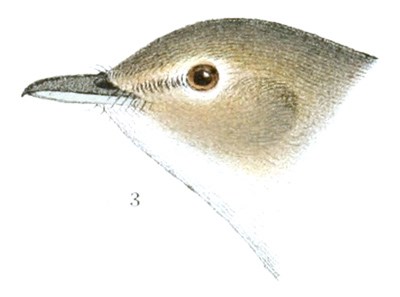
3. Vireosylvia gilvus, Vieill. ♂ Pa., 988.

4. Vireosylvia philadelphica, Cass.
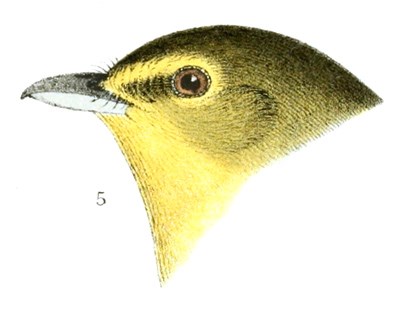
5. Lanivireo flavifrons, Vieill. ♂ Pa., 2217.
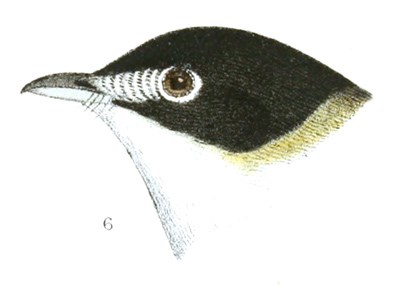
6. Vireo atricapillus, Woodh. Tex., 6818.
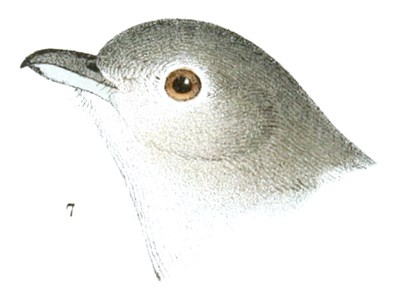
7. Vireo vicinior, Coues. ♂ Ariz., 40697.

8. Lanivireo solitaria, Wils. ♂ D. C., 37497.

9. Lanivireo cassini, Xantus. ♂.

10. Lanivireo plumbea, Coues.♂ Ariz., 37011.
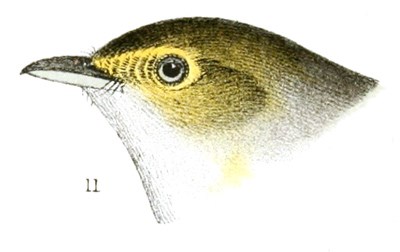
11. Vireo noveboracensis, Gm. ♂ D. C., 29248.

12. Vireo huttoni, Cass. ♂ Cal., 3725.

13. Vireo belli, Aud. ♂ Neb., 1296.

14. Vireo pusillus, Coues. ♂ Cape St. Lucas, 16354.
This Vireo has been taken several times at Charlotte Harbor, in Florida, and is thus entitled to a place in our fauna. Its distinction from a closely allied race in Jamaica, Hayti, etc., var. calidris, is shown on page 359.
A specimen belonging to Mr. Salvin (“No. 187.), from “Isthmus of Panama,” we cannot distinguish satisfactorily from typical examples of the present race, with which it is to be compared, and not with calidris. The colors are quite identical with those of barbatulus. In size it is slightly larger, the wing measuring 3.25 instead of 3.15; the tail 2.50, instead of 2.35 (from exposed base of feathers); the bill is thicker, being .20 instead of .18 deep; the third quill is longest, the second intermediate between it and the fourth; the first intermediate between the fourth and fifth. In barbatulus the second is longest, the third and fourth successively a little shorter. It is not improbable that other specimens from that locality may show greater differences, as the specimen under examination is in rather worn plumage, and has the tip of the bill broken off.
Habits. This species only claims a place in our avifauna on the ground of its presence in Florida. How abundant it is there is not determined, further than it has been observed within a restricted locality by Dr. Heermann. This was at Charlotte Harbor, on the southwestern coast. They appeared to be visitors only, from a more southern clime. They reached Florida in their northern migrations, remaining only for a short season, but evidently staying long enough to breed. Dr. Heermann states that this species resembles, in manners and in appearance, the common Red-eyed Vireo of the more northern States. He describes its song as clear and musical, and very distinctly uttered. It was constantly on the search for insects, and appeared even more active than any of the northern species, darting among the foliage, peering into crevices and cobwebs, suspended from branches with its back downward, and occasionally chasing a flying insect in the manner of a true Flycatcher. These movements were usually accompanied by a song. This species was not abundant, though Dr. Heermann saw it frequently, and obtained several specimens.
Dr. Bryant found this species very abundant at the Bahamas, arriving there about the first of May. All the specimens he obtained were males, the females not arriving there until after the 13th of May. The notes of these birds, he states, vary, though the most common one resembles whīp tom kĕllȳ pheūū, pronouncing the first word distinctly.
This bird,76 in Brown’s History of Jamaica, is called “Whip-tom-kelly,” from the supposed resemblance of its notes to these articulate sounds, and this popular appellation has been given it by various other writers. Mr. Gosse, however, in his Birds of Jamaica, calls this bird “John-to-whit,” and can find no resemblance in its notes to the words referred to. He describes its song as uttered with incessant iteration and untiring energy, and as resembling Sweet-John! John to whit! sweet John to whit! After July the notes change to to-whit-to-whoo, and sometimes to a soft, simple chirp, whispered so gently as scarcely to be audible. The name of Whip-tom-kelly Mr. Gosse never heard applied to it in Jamaica. Yet it is a bird often heard, and one whose notes have a similarity to articulate sounds, and naturally suggest a common appellation. It is very vociferous and pertinacious in its calls, repeating them with energy every two or three seconds.
This species, he states, does not ordinarily sit on a prominent twig, or dart out after insects, though it has been seen in eager pursuit of a butterfly. It seems to live in the centre of thick woods. It does not pass the winter in Jamaica, but leaves at the beginning of October, returning as early as the 20th of March. Its food he states to be both animal and vegetable, as he found in its stomach the seeds of the tropical plants and berries. In April, Mr. Gosse observed it hunting insects by the borders of the Bluefields River, and so intent upon its occupation as to allow of a very near approach. It sought insects among the grass and low herbage, perching on the stalks of weeds, and darting out after both vagrant and stationary prey. They incubate in June and July.
Like all this genus the Long-billed Vireo builds a pensile nest of great architectural ingenuity and beauty. It is a deep cup, usually about two thirds of a sphere in shape, truncated at the top. The materials of which it is made are often somewhat coarse. Mr. Gosse describes it as about as large as an ordinary teacup, narrowed at the mouth, composed of dry grasses, silk, cotton, lichens, and spiders’-web. It is usually suspended from the fork of two twigs, the margin very neatly overwoven to embrace them. The materials are well interwoven, and the walls firm and close, though not very thick. The whole is smoothly lined with slender vegetable fibres resembling human hair. One nest had its cavity nearly filled with a mass of white cotton, interwoven with the other materials, which, being picked cotton, had evidently been taken from some yard or building.
The eggs of this species are three in number, of a brilliant white, delicately tinted with pink, and marked with a few fine red and red-brown spots, usually about the larger end.
An egg of the variety from Cuba is of an oblong-oval shape, slightly pointed at one end, and the markings of faint purple and of dark purplish-brown, in bold dashes, are all about the larger end. Another from the same locality is more distinctly rounded at one and pointed at the other end, and is marked with fine brown dots distributed over the whole egg. These eggs measure, one .825 by .55 of an inch, and the other .78 by .55. An egg from Jamaica is of an extremely oblong-oval, measuring .88 by .55 of an inch, and is boldly marked more or less over the entire egg with large blotches of purplish-brown.
The Messrs. Newton describe the nest of the calidris of St. Croix as a beautiful structure, shaped like an inverted cone, composed outwardly of dried blades of grass, dried leaves, and wool, woven round the twigs, to which it was attached with spiders’-webs, lined inside with finer blades of grass, and about three inches and a half in diameter, and five in height. The eggs, three in number, were white, with a few black spots, chiefly disposed about the larger end.
Vireosylvia olivaceus, BonapRED-EYED GREENLETMuscicapa olivacea, Linn. Syst. Nat. I, 1766, 327 (based on Edwards, tab. 253, and Catesby, pl. liv).—Wils. Lanius olivaceus, Licht. Verz. 1823, 49 (N. Amer.). Vireo olivaceus, Vieill.; Bon.; Swains. II.—Aud.—Baird, Birds N. Am. 1858, 331.—Samuels, Birds N. Eng. 270. Vireosylvia oliv. Bon. Geog. Comp. List, 1838.—Ib. Consp. 1850, 329.—Reinhardt, Vid. Med. f. 1853, 1854, 82 (Greenland).—Ib. Ibis, III, 7.—Sclater, P. Z. S. 1855, 151 (Bogota); 1859, 137, 363 (Xalapa).—A. & E. Newton, Ibis, 1859, 145.—Sclater & Salvin, Ibis, 1859, 12 (Guatemala).—Lawrence, Ann. N. Y. Lyc. VII, 1860, 246 (Cuba).—? Ibis, 1864, 394 (Derby, Engl. May, 1859).—Baird, Rev. Am. B. 1864, 333. Phyllomanes oliv. Cab. Mus. Hein. 1850-51, 63.—Ib. Jour. 1860, 404 (Costa Rica).—Gundl. Cab. Jour. 1861, 324 (Cuba; very rare). ? Vireo virescens, Vieill. Ois. Am. Sept. I, 1807, 84, pl. liii (Penna.).—? Gray, Genera, I, 267, pl. lxv. Vireo bogotensis, Bryant, Pr. Bost. Soc. VII, 1860, 227 (Bogota).—Lawrence, Ann. N. Y. Lyc. 1863 (Birds Panama, IV, No. 378).
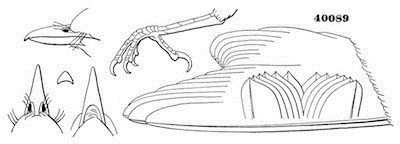
Vireo olivaceus.
40089
Sp. Char. (No. 1,418 ♂, Carlisle, Penn., May, 1844.) Upper parts olive-green. Top of head, from bill to nape, ash-color. A white line from nostrils above and beyond the eye, bordered above by a dusky line forming the edge of the ashy cap, and below by a similar, perhaps paler, loral and post-ocular cheek-stripe. Beneath, including tibiæ, white, with perhaps a tinge of olivaceous-ash across the breast; the sides of the neck like the back; sides of the body with a faint wash of olive. Axillars and crissum faintly tinged with sulphur-yellow; lining of wings and its edge, the latter especially, nearly white. Quills blackish-brown, edged externally, except at ends of primaries, with olive, internally with white. Tail-feathers lighter brown, edged externally like the back, internally with pale olivaceous-white. Bill dusky above, pale below; tarsi plumbeous; iris red. Length, 6.33; extent of wings, 10.25; wing, 3.33; tail, 2.50.
Female similar, but duller in plumage.
Hab. Whole of Eastern North America (Greenland, Halifax, Fort Simpson), west to base of Rocky Mountains, reaching Fort Bridger, and still farther northward to Bitterroot Mountains and Kootenay; south to Panama and Bogota, in winter (Xalapa only in Mexico); very rare in Cuba (only West Indian locality). Accidental in England. Trinidad. (Finsch.)

Vireo olivaceus.
Habits. The common Red-eyed Vireo is an abundant species throughout Eastern North America, from Florida to Nova Scotia on the northeast, to Lake Winnepeg on the northwest, and as far west as the Rocky Mountains. It apparently breeds wherever found, and in especial abundance in the Central States. It is a familiar and fearless species, often found, like the Warbling Vireo, in the very midst of crowded cities, and making its lively and pleasant notes heard in their public squares and private gardens, amid the ruder sounds of the neighboring streets. It breeds in Texas and Louisiana, at the Southwest, and also in abundance, at least as far as Halifax, in the opposite direction. At Fort Resolution, at the Cumberland House, and at Fort Simpson, the nests and eggs of this species were procured by Kennicott and Ross. A single specimen of the bird has been procured in Greenland, and another accidental specimen was shot in England. Specimens have also been procured in Central America.
This Vireo, like all of its peculiar and well-marked genus, prefers the forests or the tops of large and shady trees, obtains its food usually among, their upper branches, and very rarely approaches the ground. It is not exclusively sylvan, as at times it may be found around dwellings, hunting for insects and spiders; and although it hunts for food among the tree-tops, its nest is not always in such high situations, often not more than four or five feet from the ground.
In their migrations these birds enter the United States early in March, but do not make their appearance in Pennsylvania until the last of April, or in New England until the middle of May.
The Vireos procure their food, for the most part, by moving about and along branches, and among the twigs of trees, hopping from one position to another, and securing their prey without the click of a Flycatcher. The insects they capture are usually not in motion, though occasionally they will take them on the wing. They also feed on several kinds of ripe berries in the autumn.
The song of this Vireo is loud, musical, simple, and pleasing. It is uttered in short, emphatic bars, and at times has a very marked resemblance to the melodious chant of the Robin, though without its volume and power. This Vireo is one of the earliest of our spring musicians, as it is also one of the most constant and untiring in its song, continuing to sing long after most of the other vocalists have become silent, and even until it is about to leave us, at the close of September. The tender and pathetic utterances of this Vireo, uttered with so much apparent animation, to judge from their sound, are in striking contrast to the apparent indifference or unconsciousness of the little vocalist who, while thus delighting the ear of the listener, seems to be all the while chiefly bent on procuring its daily supply of food, which it pursues with unabated ardor.
This Vireo builds the neat pensile nest of its race, suspending it from the fork of two or more twigs of a forest tree, at various heights of from five to fifty feet from the ground. It is cup-like in shape, and always dependent from small twigs, around which its upper edges are firmly bound. Externally it is woven of various materials, fine strips of bark, the hempen fibres of vegetables, and webs of spiders and of various caterpillars. These are compactly pressed and woven, and, as some suppose, agglutinated by the saliva of the builder. Sometimes the unmanageable materials give to the outside of the nest a rude and unfinished appearance, at others they are evenly and smoothly wrought. They are very strong, uninjured by the storms of winter, and are often made use of by other birds, by mice, and even by the same bird a second season.
A nest of this bird (S. I. Coll., 3,353) was obtained at the Cumberland House by Mr. Kennicott. It is pensile, like all others, but is composed almost exclusively of pine-needles,—a dry and hard material, difficult of management in making such a nest. With these are intermingled a few bits of moss, fine strips of bark, and flax-like vegetable fibres. Within this rude basket is an inner nest, made up of fine dry grasses, strips of bark, and pine leaves. The external fabric is loosely put together,—an unusual feature,—but the inner portion, in the firmness and strength with which it was made, is in remarkable contrast.
The Red-eyed Vireo’s nest is often chosen by the Cowbird for the deposition of her parasitic eggs, and these foster-parents are singularly devoted in the care of their alien guests, whom they tenderly nurture, even to the neglect of their own offspring. In one instance three eggs of a Cowbird were deposited in the nest of the Vireo before any of her own, and, without laying any, the female Vireo proceeded to sit upon and hatch the intruders. In another case, where two of the Vireo’s had been laid, two Cowbird’s eggs were added. The Vireo stopped laying, and proceeded to incubate. In each instance the female Vireo seemed to forego her own natural aspirations, and at once conform to the new situation.
The male Vireo often evinces great courage and spirit in the defence of his nest, when the young are hatched driving away intruders, and even flying in the face of a man who approaches too near.
Mr. Nuttall states that the young of the Red-eyed Vireo feed eagerly upon the berries of the cornel and the Viburnum dentatum, and other shrubs. A young bird kept in confinement soon became very gentle, and readily ate flies and grasshoppers from his hand, and viburnum berries. A tame Kingbird in the same room was very jealous of and tyrannized over him, so as to compel him to seek protection from his captor. The Vireos, like Flycatchers, have the power to regurgitate by the bill pellets of indigestible portions of their food.
The eggs of this Vireo vary greatly in size, according to the locality; the farther south the smaller they are found. One, marked on the shell East Tennessee, June 1, 1858, Alex. Gerhardt, measures .78 by .52 of an inch, while one from Halifax, Nova Scotia, measures .95 by .65. The ground-color of all is a clear crystal-white, and they are marked chiefly at the larger end with spots and finer dots of red-brown.
Mr. Robert Kennicott, in his notes, speaks of finding a nest of the Red-eyed Vireo at the Cumberland House, Saskatchewan, June 28. Incubation had not yet commenced. The pensile and neatly built nest was suspended about four feet from the ground, upon a hazel-bush. The parent, when scared from it, remained near until she was killed.
Vireosylvia flavoviridis, CassinYELLOW-GREEN VIREOVireosylvia flav. Cassin, Pr. A. N. Sc. V, Feb. 1851, 152.—Ib. VI. pl. ii (Panama).—Sclater, P. Z. S. 1856, 298 (Cordova).—Ib. 1859, 375 (Oaxaca; April).—Ib. Catal. 1861, 44, No. 264.—Sclater & Salvin, Ibis, I, 1859, 12 (Guatemala).—Baird, Rev. 336. Vireo flav. Baird, Birds N. Am. 1858, 332. Phyllomanes flav. Cab. Jour. 1861, 93 (Costa Rica).

Vireo flavoviridis.
38929
Sp. Char. (No. 3,976 ♂.) Above olive-green; the whole top of head and nape ash-color, the edges of this cap and a loral line dusky, but not very decidedly so. A grayish-white line from nostrils over the eye. Beneath white, the sides of the neck, breast, and body bright olivaceous-yellow; the axillars and crissum rich sulphur-yellow. On the breast the yellow extends almost to the median line, the color of opposite sides separated by a narrow interval. Quills dusky-brown; margined externally, except at ends of primaries, with olive-green, internally with grayish-white of a decided yellow shade. Tail-feathers dark olivaceous-brown, bright olive externally, internally olivaceous-yellow. Iris yellow or “red.”
Bill horn-color, paler below. Legs plumbeous. Wings long and pointed. Second and third quills nearly equal; fourth a little less; first about intermediate between fourth and fifth. Total length, 6.00; wing, 3.20; tail, 2.60.
Hab. From northern border of Mexico to Isthmus of Panama, especially on west side.
This species has not yet been recorded as taken within the limits of the United States, but it comes so near to our southern border that it doubtless sometimes crosses the line. Nothing distinctive appears to be known of its habits.
Vireosylvia philadelphicus, CassinPHILADELPHIA GREENLETVireosylvia philadelphica, Cassin, Pr. A. N. Sc. V, Feb. 1857, 153.—Ib. VI, pl. i, fig. 1 (Philadelphia).—Sclater & Salvin, Ibis, I, 1859, 12 (Guatemala).—Baird, Rev. Am. Birds, 340. Vireo philadelphicus, Baird, Birds N. Am. 1858, 335, pl. lxxviii, fig. 3. Vireosylvia cobanensis, Sclater, P. Z. S. 1860, 463 (Coban).—Ib. Ann. Mag. N. H. 1861, 328.

V. philadelphicus.
4364
Sp. Char. (No. 20,643 ♂.) Above dark olive-green, tinged with plumbeous-ash except on the rump; top of head and nape purer plumbeous-ash, not edged with dusky, the line of demarcation indistinct. Beneath light sulphur-yellow, paler and almost white on chin and middle of abdomen; sides more olivaceous. A whitish stripe from bill over eye, as also a patch beneath it and the eyelids. A dusky loral and post-ocular spot. Quills and rectrices brown, edged externally with olive, internally with whitish; the larger coverts with paler outer edges. Bill blackish, paler plumbeous below. Legs plumbeous. Spurious outer or first quill (seen in gilva) wanting; the outer about equal to fifth; third longest; second and fourth not much shorter. Total length, 4.80; wing, 2.60; tail, 2.25.




